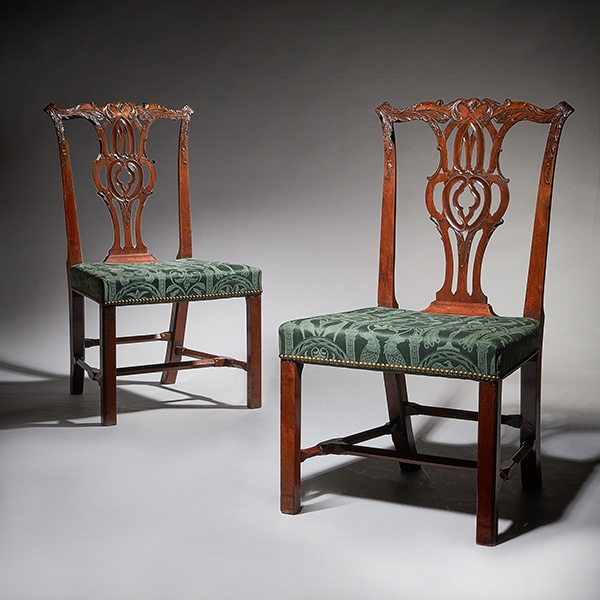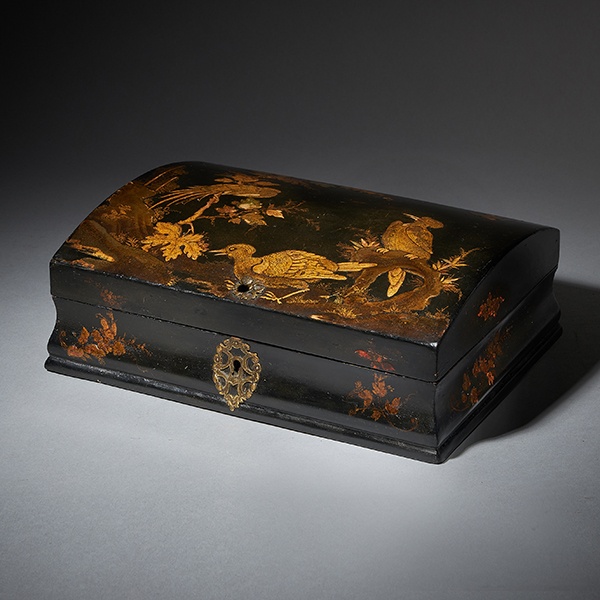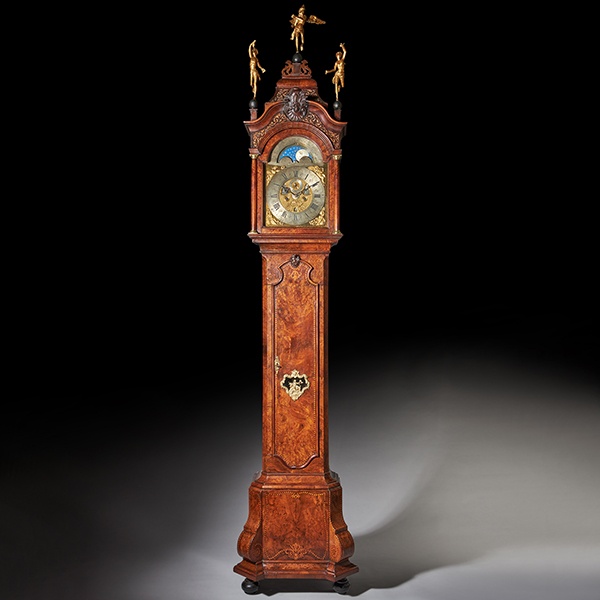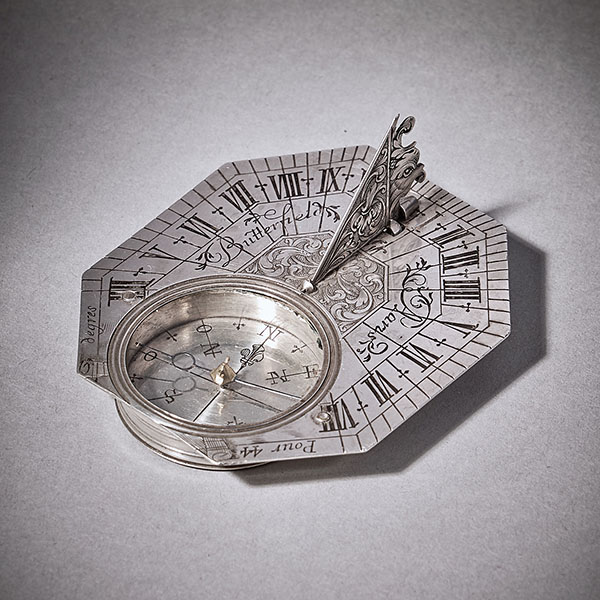A Fine 18th-century Queen Anne Burr Walnut Eight-Day Longcase Clock
Sold
Request Information
Follow Us
A Fine 18th-century Queen Anne Burr Walnut Eight-Day Longcase Clock
A superb early 18th-century eight-day Queen Anne longcase clock by the famous maker Christopher Gould, c. 1705-10.
The exquisite burr walnut veneered oak case is of the highest quality, having a square hood and a trunk door framed with walnut D-mouldings. The hood has fine sound frets and is flanked by ebonised columns with gilt wooden capitals and bases. It has viewing windows to the sides. The base, which is in perfect harmony with the hood, has shallow stepped mouldings, typical of the period and a plinth at the bottom.
The eight-day movement has going and striking trains and is in remarkably original state. The going train has anchor escapement with seconds pendulum, while the striking is regulated by an inside count wheel. The beautifully executed 12-inch brass dial has a silvered chapter ring, a subsidiary seconds ring under the XII and finely engraved date aperture above the VI in the matted centre. The chapter ring has the classic division into Roman numerals with fine half-hour markers, an inner track with quarter-hour divisions, which adds to its elegance, and Arabic five-minute divisions on the outside. It is signed along the bottom Chr Gould London. The time is indicated by a fine pair of period blued-steel hands, the hour hand richly pierced. The winding holes are ringed whilst the corners are embellished by superb putti-and-crown spandrels.
The maker
Christopher Gould was made a free Brother in the Clockmakers’ Company in1682 and referred to as great clockmaker. Strangely enough, it is not known to whom he was apprenticed, but it must have been one of the most eminent makers of the time, as Gould became a prolific and outstanding maker. He was married to Mary Rand in 1684, a second time in 1702, to Jane Cosham. The couple had several children. Gould had a great number of apprentices. Apart from longcase clocks, for which he was most famous, he also made bracket clocks, lantern clocks, even for the Turkish market, hooded clocks and watches. He probably died in 1718.
Condition
Good. Exquisite original condition and of exceptional colour. The movement has been beautifully maintained and serviced by our horologist.
Dimensions
Height: 87.41 in. (222 cm)
Width: 17.72 in. (45 cm)
Depth: 9.85 in. (25 cm)
PREVIOUSLY SOLD
No Results Found
The page you requested could not be found. Try refining your search, or use the navigation above to locate the post.
No Results Found
The page you requested could not be found. Try refining your search, or use the navigation above to locate the post.
YOU MAY ALSO LIKE

Pair of 18th Century George III Carved Mahogany Chippendale Chairs
Pair of 18th Century George III Carved Mahogany Chippendale Chairs £8,900Follow UsPair of 18th Century George III Carved Mahogany Chippendale Chairs A simply superb pair of carved George III mahogany chairs, C.1770. Condition Good. Wear...

18th Century Japanned Chinoiserie Dome-Topped Box, Circa 1715-1725
18th Century Japanned Chinoiserie Dome-Topped Box, Circa 1715-1725 £3,800Follow Us18th Century Japanned Chinoiserie Dome-Topped Box, Circa 1715-1725 Early 18th century George I Japanned Chinoiserie dome-topped box, Circa 1715-1725. England or...

Magnificent 18th Century Striking Dutch Amsterdam Burl Walnut Longcase Clock
Magnificent 18th Century Striking Dutch Amsterdam Burl Walnut Longcase Clock £26,000Follow UsMagnificent 18th Century Striking Dutch Amsterdam Burl Walnut Longcase Clock An impressive Dutch longcase clock with a burr walnut veneered oak case,...

18th Century George III Mahogany Wine Cooler or Cellarette
18th Century George III Mahogany Wine Cooler or Cellarette £4,600Follow Us18th Century George III Mahogany Wine Cooler or Cellarette A fine and well-figured George III mahogany hexagonal wine cooler or cellarette on the original stand, C....

Striking 19th Century Carriage Clock with a Gilt-Brass Corniche Case by Grohé
Striking 19th Century Carriage Clock with a Gilt-Brass Corniche Case by Grohé £3,995 Follow UsStriking 19th Century Carriage Clock with a Gilt-Brass Corniche Case by Grohé Striking carriage clock with a gilt-brass corniche case by Grohé,...

Rare Silver Pocket Sundial and Compass by Michael Butterfield, Paris, circa 1700
Rare Silver Pocket Sundial and Compass by Michael Butterfield, Paris, circa 1700 £4,900 Follow UsRare Silver Pocket Sundial and Compass by Michael Butterfield, Paris, circa 1700 A beautiful, rare solid silver Anglo-French octagonal pocket...

Pair of 18th Century George III Carved Mahogany Chippendale Chairs
Pair of 18th Century George III Carved Mahogany Chippendale Chairs £8,900Follow UsPair of 18th Century George III Carved Mahogany Chippendale Chairs A simply superb pair of carved George III mahogany chairs, C.1770. Condition Good. Wear...

18th Century Japanned Chinoiserie Dome-Topped Box, Circa 1715-1725
18th Century Japanned Chinoiserie Dome-Topped Box, Circa 1715-1725 £3,800Follow Us18th Century Japanned Chinoiserie Dome-Topped Box, Circa 1715-1725 Early 18th century George I Japanned Chinoiserie dome-topped box, Circa 1715-1725. England or...

Magnificent 18th Century Striking Dutch Amsterdam Burl Walnut Longcase Clock
Magnificent 18th Century Striking Dutch Amsterdam Burl Walnut Longcase Clock £26,000Follow UsMagnificent 18th Century Striking Dutch Amsterdam Burl Walnut Longcase Clock An impressive Dutch longcase clock with a burr walnut veneered oak case,...

18th Century George III Mahogany Wine Cooler or Cellarette
18th Century George III Mahogany Wine Cooler or Cellarette £4,600Follow Us18th Century George III Mahogany Wine Cooler or Cellarette A fine and well-figured George III mahogany hexagonal wine cooler or cellarette on the original stand, C....

Striking 19th Century Carriage Clock with a Gilt-Brass Corniche Case by Grohé
Striking 19th Century Carriage Clock with a Gilt-Brass Corniche Case by Grohé £3,995 Follow UsStriking 19th Century Carriage Clock with a Gilt-Brass Corniche Case by Grohé Striking carriage clock with a gilt-brass corniche case by Grohé,...

Rare Silver Pocket Sundial and Compass by Michael Butterfield, Paris, circa 1700
Rare Silver Pocket Sundial and Compass by Michael Butterfield, Paris, circa 1700 £4,900 Follow UsRare Silver Pocket Sundial and Compass by Michael Butterfield, Paris, circa 1700 A beautiful, rare solid silver Anglo-French octagonal pocket...










